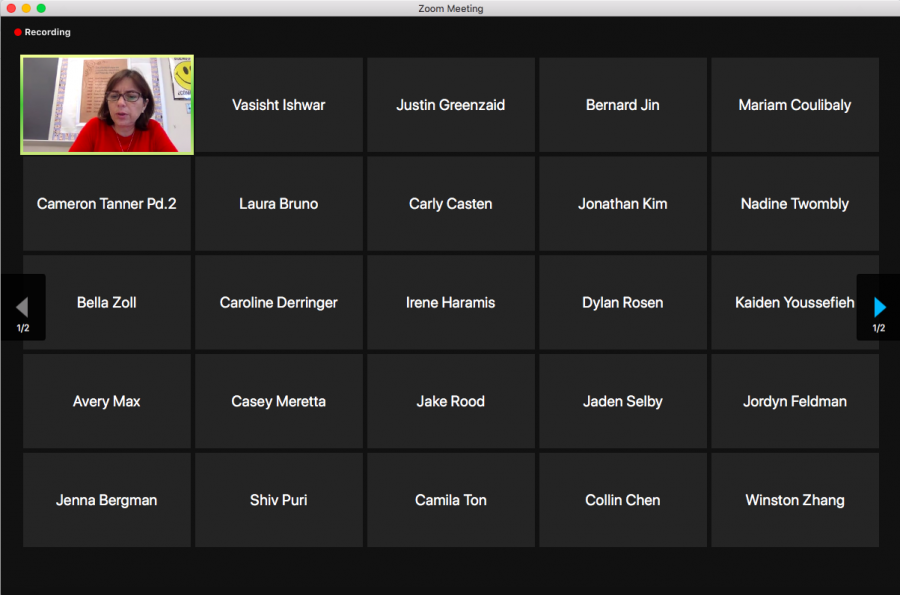Virtual classes give students a new perspective on the most beneficial way to learn
Shown is what a typical Zoom class may look like during the 2020-2021 school year, in which there are almost no cameras on entirely.
April 21, 2021
The blaring radar of the default iPhone alarm is a common sound for many WCHS students in the morning (unless they have changed their alarm sound due to the trauma it may cause). But, looking back at a year from today, many students had no alarm set at all. This is largely due to the fact that there were no Zoom classes a year ago.
Students had the freedom to wake up whenever they wanted, eat whenever they wanted and learn whenever they wanted. Their only responsibility was to complete the asynchronous work given to them within the time frame needed. Now, however, students have the responsibility of a 9:00 a.m. first period class and have a designated time for them to eat lunch. It feels a bit more like regular, in-person school.
“I like the more relaxed feel that online school had last year versus this year. I was able to sleep a lot more then than now,” WCHS sophomore Vasisht Ishwar said. “Last year we had much less of an obligation to our classes, which made school a lot more laid back and easier on me.”
A year ago students did not even have a schedule that they had to worry about. All assignments were self-paced and for the most part self-taught. It was entirely up to the student themself if they wanted to wake up at 8:00 a.m. to grind out their entire week’s work, or if they wanted to roll out of bed at 11:00 a.m. and do their work day-by-day.
Now that there are Zoom meetings in a class-like setting with teachers, students are technically required by law to attend class. This means taking notes and responding to the teacher’s questions for an hour straight, or it means hitting the join meeting button and snoozing back to sleep. Regardless, students are now receiving various different levels of learning just based on their own engagement.
“I liked how I could complete all of my work on my own time last year. I could make a schedule that worked for me instead of having specific due dates for classwork and homework,” WCHS sophomore Anna Rubino said.
Obviously, with more freedom and more relaxed schooling, students may also be receiving much less of an education. I mean, will the teacher even really notice if I copy my friend’s work in all seven of my classes? Now, that might seem very obvious, yet, many students did just that, and for some, it worked out just fine. Despite the fact that they may not be able to retain any information from last year’s fourth quarter, some students were able to receive straight A’s whilst putting forth minimum effort.
Taking in that last paragraph, it should be very clear to you by now that the current way of virtual learning does require the students to actually learn more. Still not as much as “normal” school, but a lot more than when the pandemic first began. Having to take tests and do assignments while in a meeting with your teacher will force you to actually do your own work. Especially when that teacher may ask that you turn your camera on during the test so that they can physically watch you do your own work. Yes, that is what it has come to.
“I do feel that the way we’ve done school online this year is an improvement from last year. The increase in teacher-led class time has helped me better understand what I am learning in my classes,” Rubino said. “I like that virtual this year was much more organized than the virtual school at the end of last year. I also like that this year’s virtual school is more similar to the schedule we would have in in-person school.”
There are pros and cons to both ways of virtual learning, but it is universally known that in-person teaching is a lot more beneficial. Some students find it extremely difficult to learn strictly on a computer. Some may even have to watch Crash Course or Khan Academy videos on their own just to keep pace with the material they are being given, which is a lot at this point in the year.
Teachers try to make up for not seeing each of their students for 225 minutes a week anymore by giving out enough work that will fill that time on their own. There is now more work assigned weekly than ever, and if it is beneficial or not is questionable. One or two assignments weekly for each class sounds pretty good right about now, which is what most students’ workloads looked like last year.
“If I could change one thing about our current virtual situation I would change the amount of work we are given. We receive a ton of assignments that seem almost entirely useless to what we are even doing in class,” Ishwar said. “They just consume more and more of my time and that time could definitely be spent better if I could learn on my own.”
Eating lunch could be done at any time of the day in the initial virtual school system. Students are now given over an hour of time designated for lunch which seems like a lot, but is not really much compared to last year. If a student wanted to eat lunch at noon they could or even 3 p.m. for that matter. Now, students are permitted to eat lunch at 11:15 a.m. and if not they may be hungry for the rest of the day.
Regardless of which type of virtual scenario students prefer and which benefits them the most, it is undeniable that there will be changes to how in-person school continues going forward. Many have probed the matter of having snow days off now that there is a virtual school system in place. In the end, the current schedule does sound a lot better than 7:45 a.m. start times, and a gut-wrenching amount of homework and assignments given from all seven classes in a one-day span.
“I do think that some aspects of virtual learning will stay even when we go in person. I think that having Wednesdays as a day to catch up on work and meet with teachers will stay because it allows students who need more help to get the individual help they need. It also helps prevent students from falling behind,” Rubino said. “Also, I think we will have no more snow days because of virtual learning since the technology to do virtual school is so familiar to the students and teachers.”



